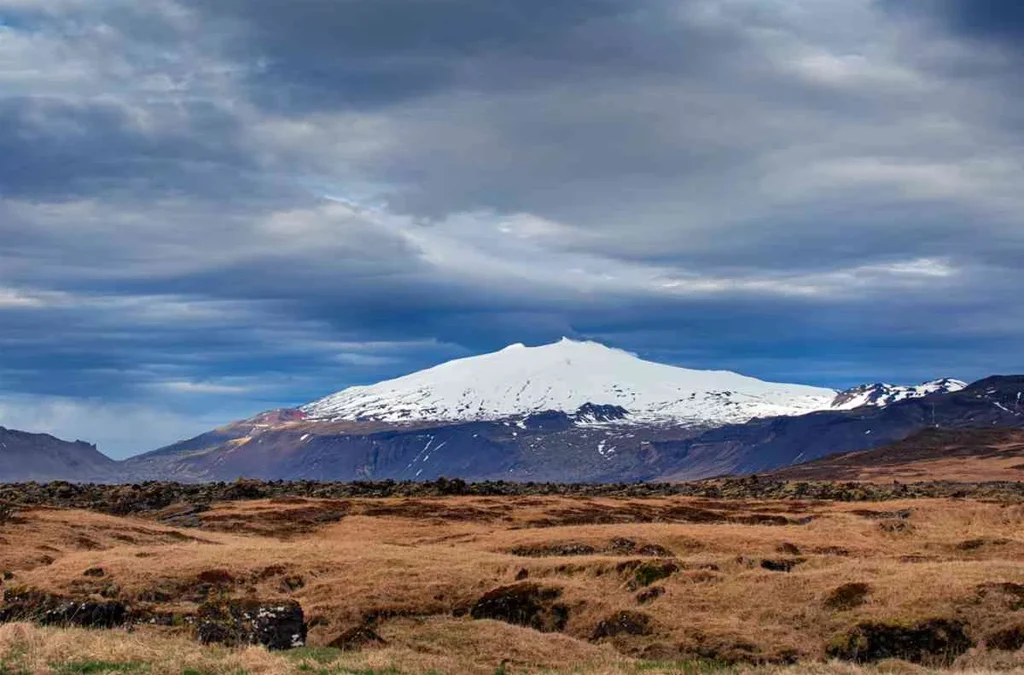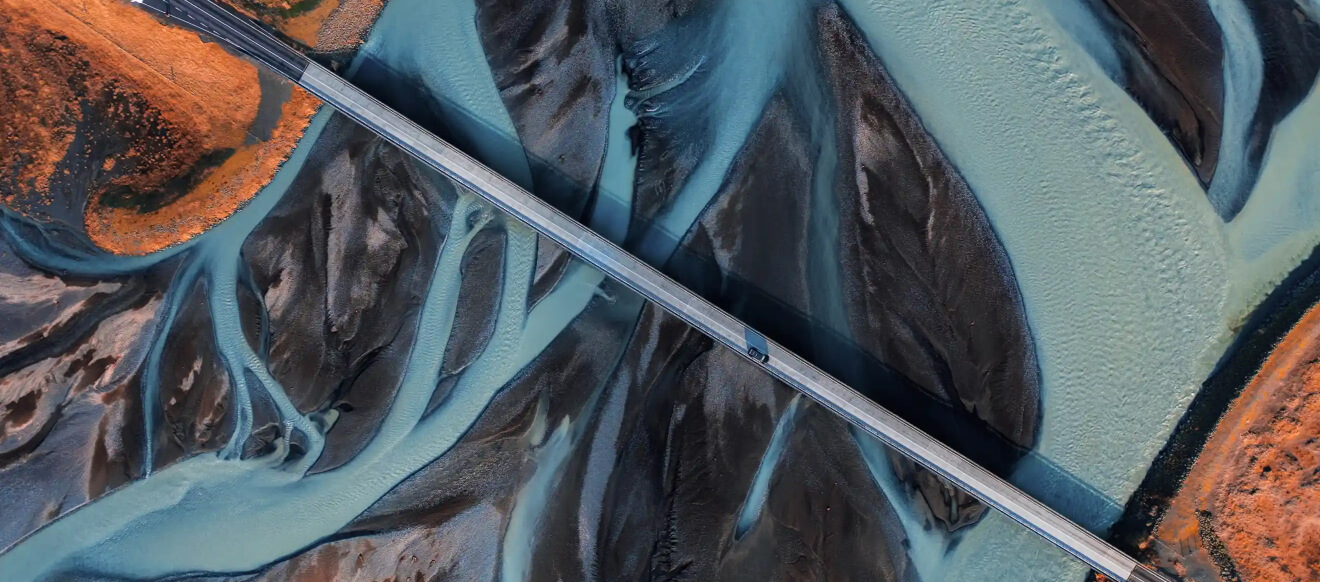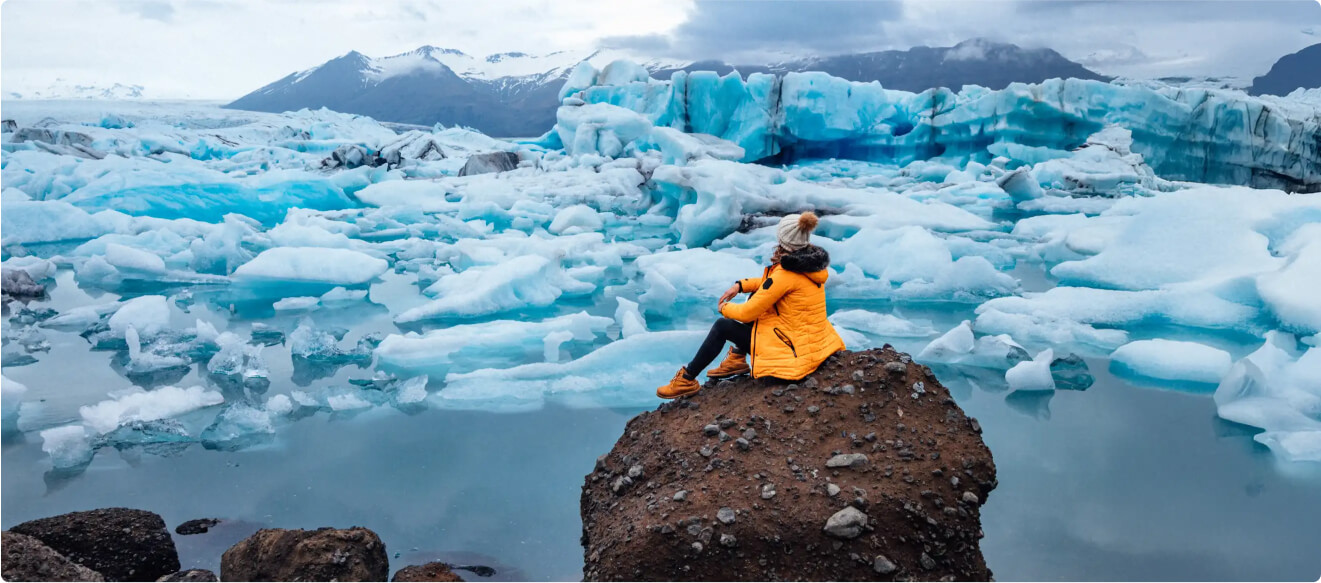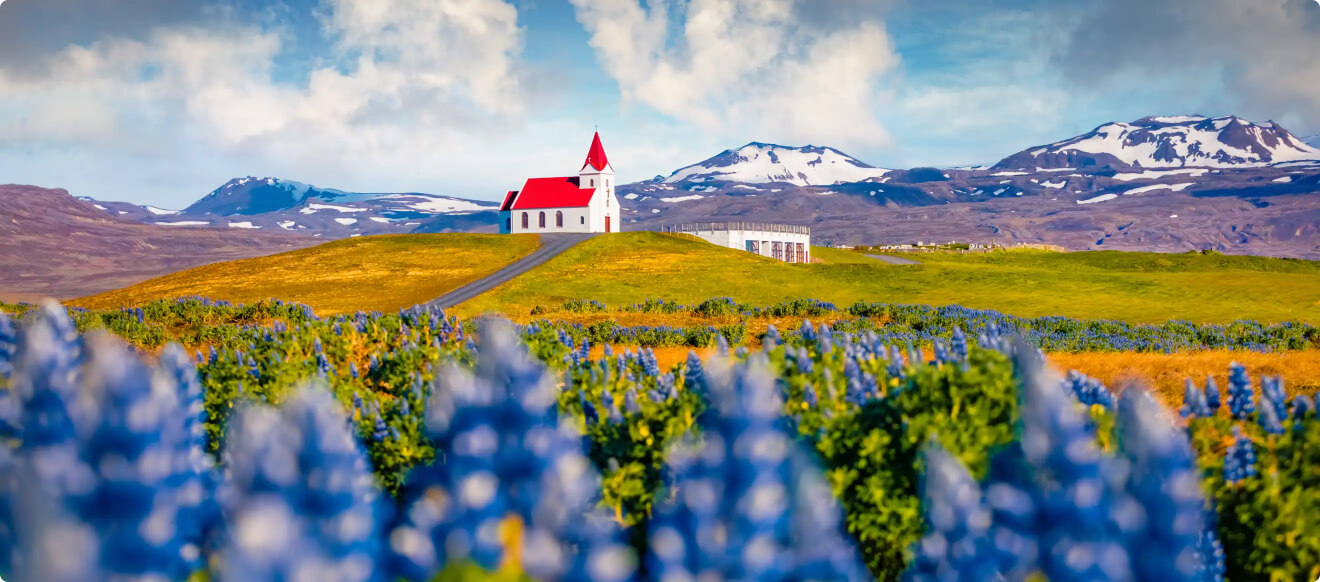The Snæfellsjökull National Park is a true haven for adventure seekers. The range of activities it offers is as diverse as its stunning landscape. Here's a look at some of the key things to do at Snæfellsjökull National Park:
For those looking to hike in Iceland, a Snæfellsjökull glacier hike is a must-try. It's a thrilling journey that takes you through shifting landscapes, from lush mossy lava fields to the icy terrains of the glacier. For those with a penchant for heights, climbing the glacier offers an unmatched adventure with an extraordinary panorama of the surroundings.
And suppose you prefer the exhilarating rush of snowmobile tours as you zoom across the expansive icy wilderness. In that case, Snæfellsjökull offers that as well! To continue your Icelandic adventure, you can also explore the wonders of Thingvellir National Park. This stunning location is just a stone's throw away and worth checking out!
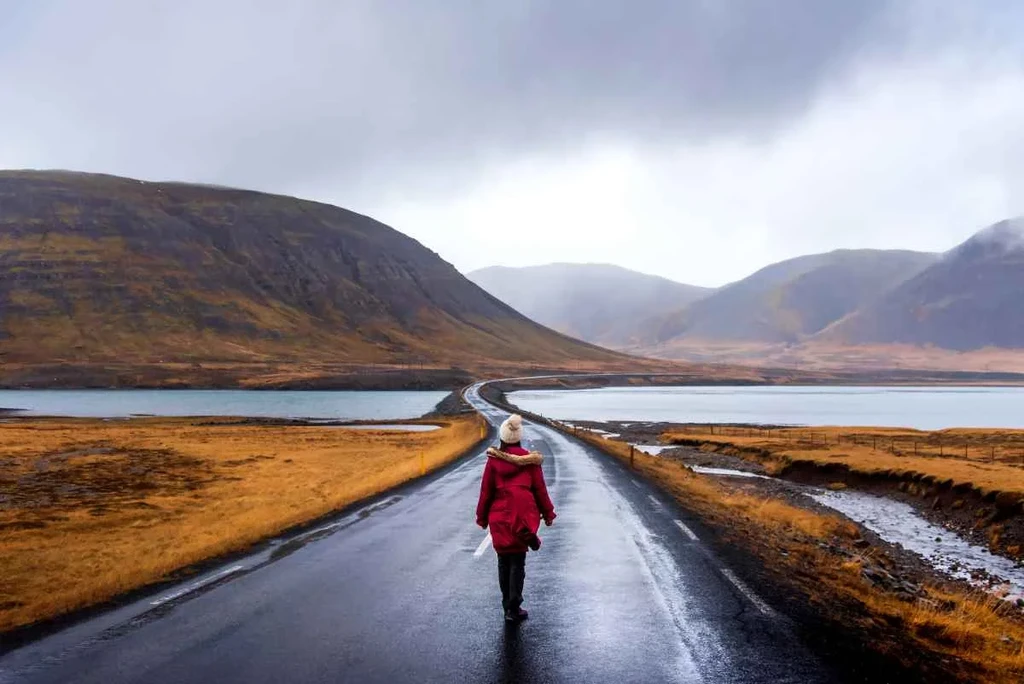
Overview of Snæfellsjökull in Iceland
When discussing Iceland's natural wonders, it's easy to get mixed up between Snæfellsjökull, Snæfell, and 'Sneffels.' So, let's clear up any confusion!
Snæfellsjökull is the stunning glacier-capped volcano at the western tip of the Snæfellsnes Peninsula. Meanwhile, Snæfell is a separate mountain located in East Iceland, and 'Sneffels' is sometimes incorrectly used in English contexts to refer to Snæfellsjökull. However, they are distinct locations! Snæfellsjökull itself is a breathtaking glacier-capped stratovolcano that’s about 700,000 years old, standing tall at 1,446 meters (4,750 feet).
It's the crown jewel of Snæfellsnes National Park, which was established in 2001 and spans roughly 170 square kilometers (66 square miles). The park is famous for its diverse landscapes, including coastal cliffs, lava fields, and historical relics. It's a must-see for anyone visiting Iceland's west coast, blending natural beauty with rich history.
Geological Features of Snæfellsjökull
Glaciers in Iceland are fascinating, and Snæfellsjökull is no exception. There is so much to talk about Snæfellsjökull's geological features—but let's briefly cover the basics first. The mountain is a stratovolcano, also known as a composite cone volcano, meaning it consists of layers of hardened lava, ash, pumice, and tephra. Some layers have been carbon-dated back to 1,800 years ago! The glacier covering most of the mountain summit is approximately 700 meters (2,300 feet) thick. 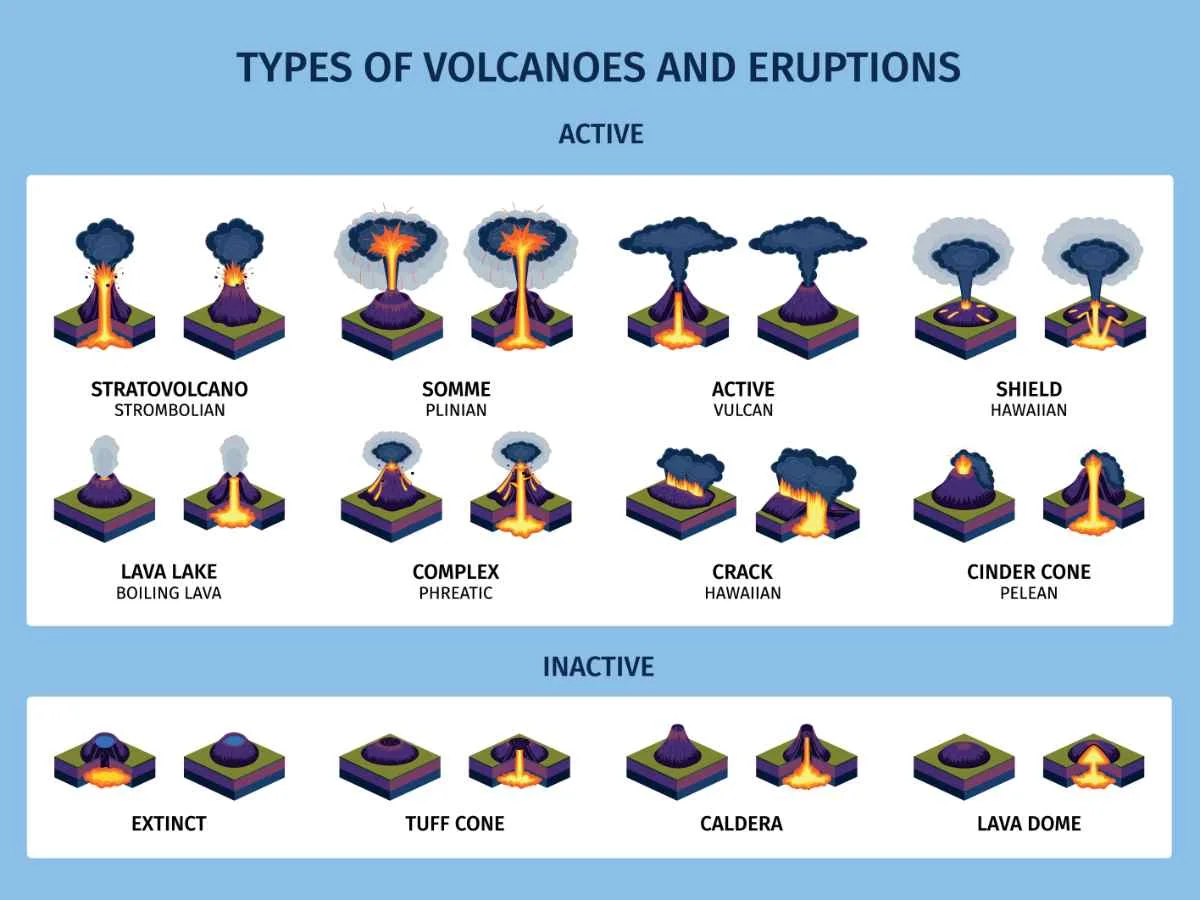
Volcanic Characteristics of Snæfellsjökull Volcano
The Snæfellsjökull volcano, also sometimes referred to as 'Snaefell volcano,' is a striking stratovolcano with a classic conical shape, formed from layers of lava, ash, and tephra over thousands of years. Although it's considered an active volcano, its last eruption was nearly 2,000 years ago, around 200 CE, and was explosive, originating from the summit crater. Can you imagine the fireworks?
This unique landscape is dotted with craters like Purkhólar and Hólahólar, rugged lava fields, and fascinating geological features like volcanic plugs and palagonite tuff. The area features two lava types: rough, jagged lava and smooth, ropy lava. Some caves within Snæfellsjökull volcano require guided access for safety.
Glacial Aspects of Snæfellsjökull Glacier
The Snæfellsjökull glacier, spanning about 11 square kilometers (4 square kilometers), majestically crowns the Snæfell volcano, making it one of Iceland's most visited glaciers. Formed from layers of snow compacting into ice over centuries, this glacier has become an iconic feature of the landscape.
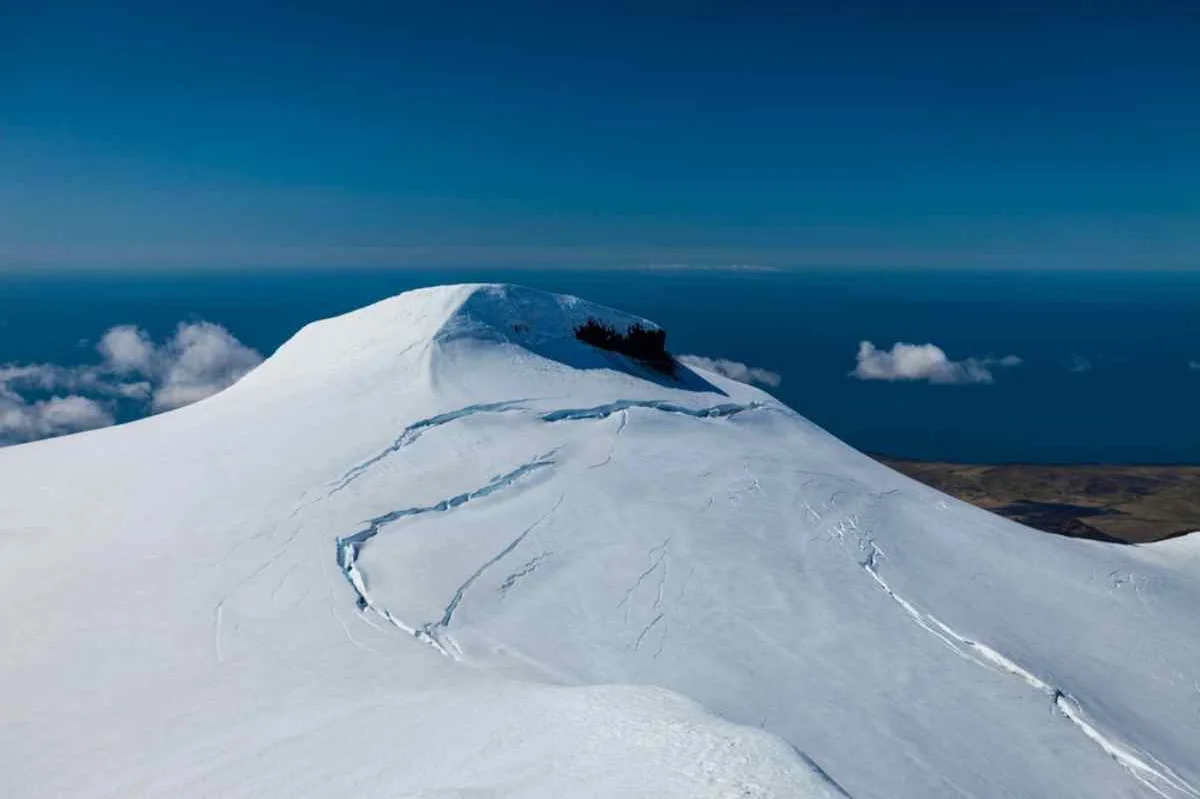
Historical and Cultural Significance of Snæfellsjökull Glacier
Snæfellsjökull Glacier is steeped in rich culture and history, mentioned countless times in Icelandic folklore, literature, and legend. Why is this glacier so iconic? What secrets does it hold? Well, keep reading because you won't want to miss this next part.
Historical Background
Snæfellsjökull has deep roots in Iceland's history. For over 1,100 years, people have settled around this area, with sites like Forni Saxhóll and Berutóftir dating back to those early days.
The 13th century saw a population surge here, driven by a booming fishing industry, turning the Snæfellsnes Peninsula into a bustling hub. By the 18th century, it became one of Iceland's most densely populated areas.
This growth had a lasting impact on the environment and the local communities, with fishing still playing a central role today in villages like Hellissandur, Rif, and Ólafsvík, which continue to thrive as active fishing centers.
Snæfellsjökull in Literature
Now for the best part—literature! Yes, Snæfellsjökull has been immortalized in one of the best works of fiction. Let's take a look at some of the most famous works that mention this glacier.
Jules Verne's 'Journey to the Center of the Earth'
Snæfellsjökull shot to international fame thanks to the 1864 Jules Verne novel called 'Journey to the Center of the Earth.' In Verne's story, this glacier-capped volcano is the gateway to a mysterious underground world, sparking imaginations worldwide.
This iconic literary reference has turned Snæfellsjökull into a must-see destination for tourists and inspired countless adaptations, fueling curiosity about its unique geological and mythical significance.
Other Literary References
But wait, there's more! Snæfellsjökull isn't just famous from Jules Verne's novel—it also appears in other works, like Czech science fiction writer Ludvík Souček's Blind Birds trilogy and Icelandic author Halldór Laxness's Under the Glacier.
Local Folklore and Myths
There are plenty of Sagas, legends, and folktales that mention Snæfellsjökull, all adding to its mysterious aura. Here are the most well-known ones:
Bárðar Saga Snæfellsáss
The Bárðar saga Snæfellsáss is a 14th-century Icelandic saga that tells the story of Bárður, a half-giant and half-troll who becomes the guardian spirit of the Snæfellsnes Peninsula. Originally from Norway, Bárður moves to Iceland with his family, settling at Laugarbrekka near Snæfellsjökull.
The saga details his struggles, including the tragic loss of his nephews, prompting him to retreat into the glacier, transforming into the region's protective spirit. Revered as the 'God of Snæfellsnes,' Bárður embodies the deep, mystical bond between the landscape and its people. His legacy lives on in local folklore, with a statue in Arnarstapi honoring his guardianship.
Mystical Beliefs and Paranormal Events
Snæfellsjökull is often seen as a hotspot for mystical energy and paranormal activity. Could there be more to this place than meets the eye? The region is steeped in legends—stories of trolls turned to stone and hidden people lurking just out of sight. And if that's not intriguing enough, in 1993, a large crowd gathered here, convinced that an alien landing was about to happen on the mountain.
What's There To Do In Snæfellsjökull National Park?
We are glad you asked because there's plenty to do in and around Snæfellsjökull National Park. From hiking on the glacier and exploring lava caves to birdwatching and sightseeing, the list just goes on. Here is a breakdown of what you can expect to see and do in this stunning park:
Hiking Trails
You haven't done hiking in Iceland until you have hiked in Snæfellsjökull National Park. The diverse landscape offers a range of trails for both beginners and experienced hikers, with breathtaking views at every turn. Some of the most popular hikes include:
- Snæfellsjökull Glacier Hike: A challenging trek to the summit of Snæfellsjökull, spanning 8 km (5 miles) with an elevation gain of 760 m (2,493 feet). It takes around 3-5 hours to complete and is best for experienced hikers due to crevasses and unpredictable conditions. A guide is recommended, and the hike should be avoided in summer when large crevasses form near the summit.
- Hellnar-Arnarstapi Trail: A scenic, easy 1.5 km (0.9 miles) coastal trail connecting the villages of Hellnar and Arnarstapi. This hike takes about 30-40 minutes and offers breathtaking views of the rugged coastline, unique rock formations, sea caves, and cliffs. Perfect for a relaxing stroll with picturesque scenery.
- Rauðfeldsgjá Gorge: A 30-45 minute hike each way on a rocky, uneven trail leading to the narrow Rauðfeldsgjá Gorge. The gorge features a small stream and towering cliffs and is famous for its mention in the Bárðar Saga. An intriguing spot for exploring Icelandic folklore and natural wonders.
- Londrangar Cliffs: A 4 km (2.5 miles) round-trip hike that takes 1-2 hours, with a 100 m (328 feet) elevation gain. This trail provides stunning views of volcanic cliffs rising dramatically from the ocean and the surrounding landscape. Ideal for those looking to experience Iceland's volcanic terrain.
- Hreggnasi Hill: A short but steep 1 km (0.6 miles) hike to the 469 m (1,539 feet) summit of Hreggnasi Hill, located north of Snæfellsjökull. Suitable for all skill levels and offers panoramic views of Snæfellsjökull National Park. A quick hike with a rewarding view, perfect for any hiker.
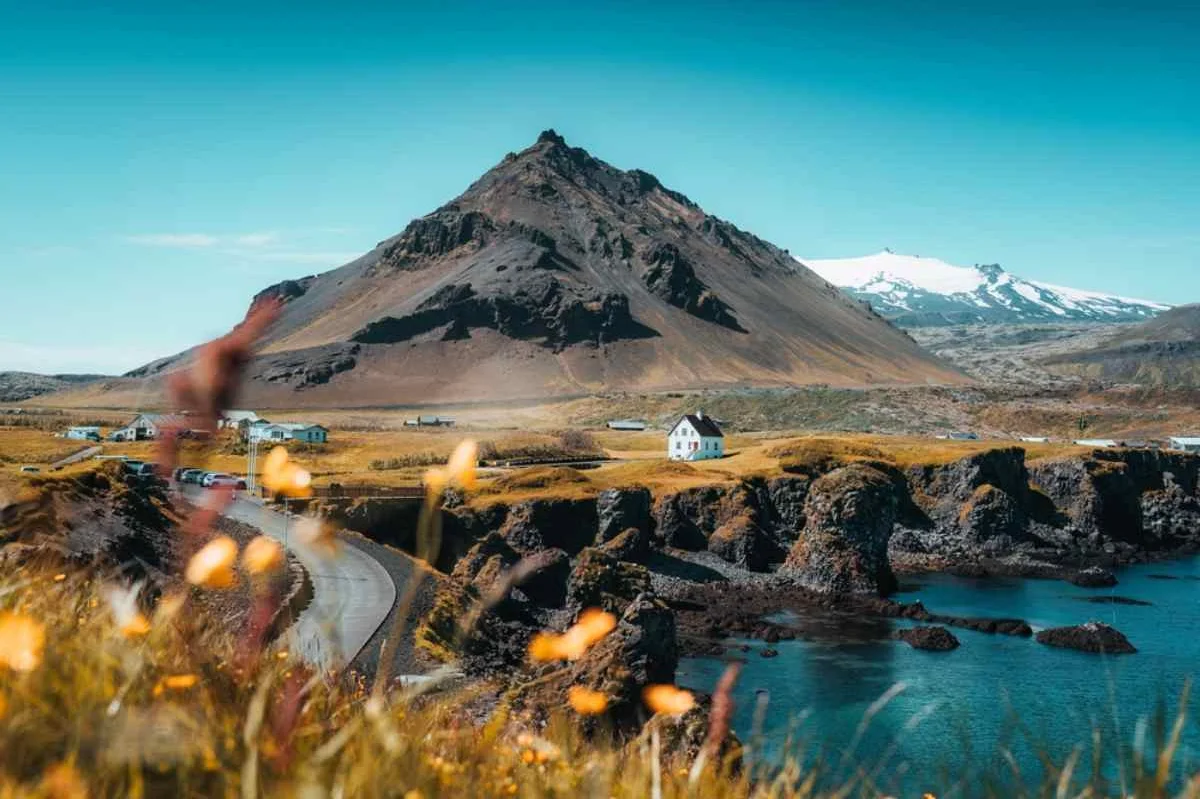
Lava Caves
As mentioned earlier, Snæfellsjökull is a glacier-capped volcano, and the surrounding landscape is dotted with lava caves. These underground formations are fascinating to explore and offer a unique perspective of the park's geology. Some of the most popular lava caves include:
- Vatnshellir Cave: Located on the western side of Snæfellsnes Peninsula, this 8000-year-old cave offers guided tours that take you 35 m (115 feet) underground through narrow tunnels and into large chambers rich in natural colors and eerie lighting.
- Sönghellir Cave: A smaller but equally impressive cave known for its excellent acoustics. But it's not just the sound that's impressive—the cave is lined with unique lava formations and a rather interesting stone arch.
Beaches and Cliffs
Snæfellsjökull National Park is not only known for its breathtaking inland features but also for its stunning coastal landscapes. The beaches and cliffs along the peninsula provide a dramatic contrast to the glacial terrain and offer various opportunities for exploration and relaxation.
- Djupalonssandur Beach: A unique black pebble beach framed by towering cliffs and the remains of a shipwreck, Djupalonssandur is a striking spot for a stroll or a picnic. The beach is surrounded by scenic rock formations, and various hiking paths lead you to spectacular viewpoints overlooking the Atlantic Ocean.
- Lóndrangar Basalt Cliffs: These iconic basalt column formations rise majestically from the sea and are a representative feature of the area. Standing at 75 meters (246 feet) high, they are the remnants of a volcanic plug and are surrounded by a wealth of birdlife, making them a prime location for bird watching.
- Arnarstapi Cliffs: Just a short hike from the village of Arnarstapi, these cliffs showcase impressive rock formations and natural arches, including the famous Gatklettur arch. The area is teeming with seabirds, particularly during nesting season, providing a vibrant backdrop against the crashing waves.
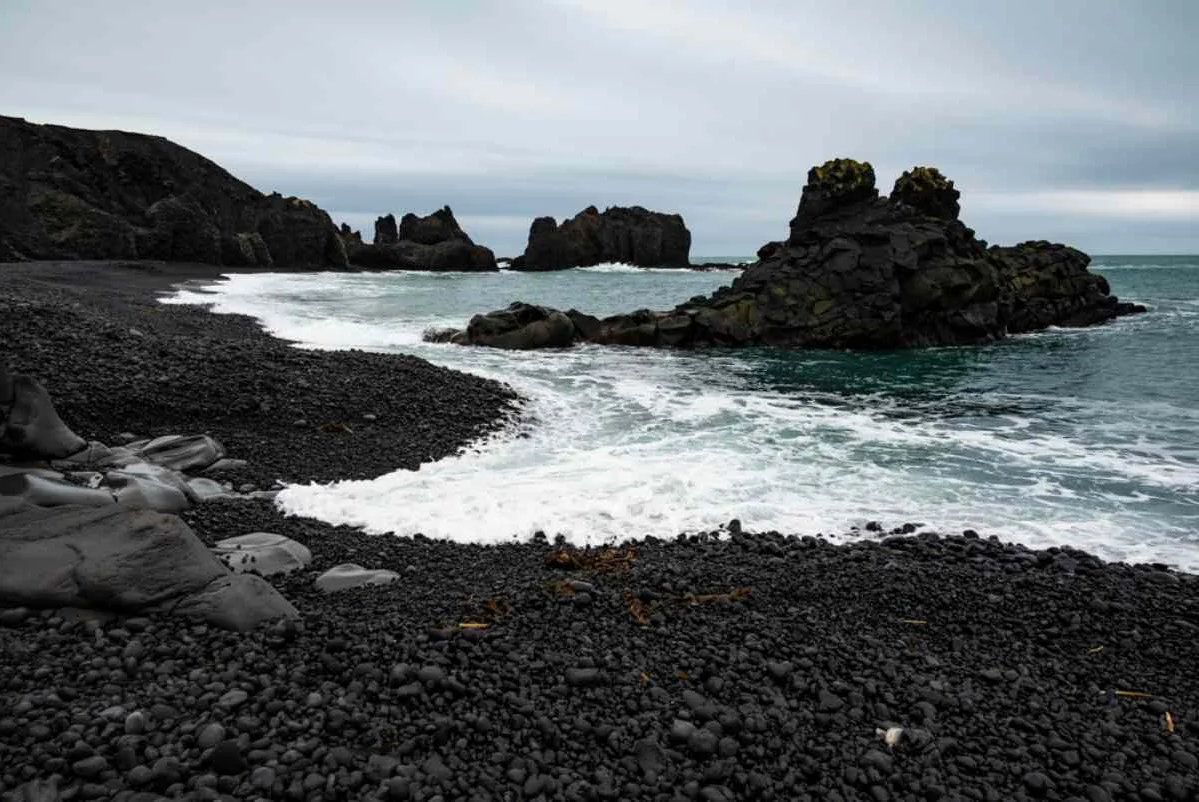
Visitor Centers and Facilities
When you visit Snæfellsjökull National Park, don't miss the chance to explore its two fantastic visitor centers, open all year!
- National Park Center at Hellissandi: Dive into the park's rich history with informative displays, pick up a unique souvenir, or relax at the restaurant Matarlist. There's even an educational space for those curious minds! Plus, it's the headquarters for the park's staff. Open every day from 10:00 to 16:00.
- Visitor Center at Malarrif: Discover a captivating educational exhibition about the park's natural wonders and grab a keepsake from the souvenir shop. Open daily from 11:00 to 16:00.
- Restrooms: There are rest areas and toilets conveniently located throughout the park, including at visitor centers, campgrounds, and parking lots.
Guided Tours and Activities
With so much to see and do in Snæfellsnes National Park, joining a guided tour or activity can be an excellent way to make the most of your visit. Whether you're seeking adventure, relaxation, or educational experiences, there are various options available for all interests and skill levels.
Hiking and Climbing Tours
North Ice offers a 12-hour hiking and climbing tour to Snæfellsjökull, departing from Reykjavík. The tour includes all necessary equipment, so you're fully prepared for the 3-4 hour ascent from the base to the summit. With expert guides by your side, you'll safely explore the glacier-capped volcano's breathtaking views and mysterious landscapes.
Snæfellsjökull Glacier Snow-cat Tour
The Snaefellsjokull Glacier Snow-cat Tour begins in Arnarstapi, close to Snæfellsjökull. After a scenic drive along a bumpy mountain pass with fantastic glacier views, you'll reach the glacier's base. Then, climb aboard the snowcat for a slow, thrilling ascent to the summit of Snæfellsjökull, soaking in stunning panoramas!
Wildlife and Plant Diversity of the Snæfellsnes Peninsula
The Snæfellsnes Peninsula is a paradise for nature lovers, boasting an impressive array of flora and fauna. With 323 species of flowering plants and ferns, this region is a vibrant representation of Iceland's boreal birch forests and alpine tundra ecosystems.
Among its unique vegetation is Scots lovage (Ligusticum scoticum), an edible plant found only on the western slopes of the peninsula. The southern coast is particularly special, with relatively undisturbed wetlands that support diverse plant life.
Birdwatchers will find plenty to marvel at, with 13 species of wading birds and over 60 bird species nesting here, including the iconic puffins, who visit during the summer. Breiðafjörður, a vital marine ecosystem, is home to extensive seaweed and kelp forests and hosts Iceland's largest populations of seals and maritime birds.
Due to a significant decline in seal numbers since 1980, seal hunting was banned in 2019, though the waters still teem with life. Killer whale pods are also a common sight in the area.
On land, the arctic fox was the top carnivore, but when species like the American mink were introduced, it had a significant impact on the ecosystem. The fox population is now protected in Snæfellsjökull National Park, ensuring this fascinating animal remains a part of Snæfellsnes’s rich natural tapestry.
How To Get to the Snæfellsjökull Peninsula
Renting a car in Iceland is by far the best way to get to the Snæfellsjökull Peninsula. After you have your rental car, reaching the Snæfellsjökull Peninsula from Reykjavik is a breeze. A 2-3 hour scenic drive along Route 1, then Route 54, will land you in this magical location. To explore the peninsula's varied terrain and make your way to the Snæfellsjökull Glacier, a 4x4 vehicle is recommended.
While the main roads leading to the glacier are usually well-maintained and accessible by regular cars during the summer, some sections off the main road may require a 4x4 vehicle, especially if you plan to explore further into the surrounding areas or venture off-road.
Plan your journey ahead and always check the weather and road conditions. The raw beauty of Snæfellsjökull, whether it's the peninsula or the majestic glacier, is worth every minute of the journey.
Best Time to Visit
Snæfellsjökull National Park is open year-round, so when's the best time to visit? It depends on what you're looking for! Summer in Iceland (June to August) offers milder weather, longer days, and accessible hiking trails, making it perfect for exploring the glacier and surrounding areas.
However, the Icelandic winter (December to March) brings a magical atmosphere, with snow-covered landscapes and the chance to see the Northern Lights above Snæfellsjökull. Keep in mind that winter conditions can be challenging, and some roads may be less accessible.
Snæfellsjökull Fun Facts
Snæfellsjökull is not only a natural wonder, but it's also a place shrouded in mystery and folklore, steeped in history, and revered in literature. It's a destination that tells a story beyond its icy facade. Here are some fascinating Snæfellsjökull fun facts:
- The volcano is currently dormant. The last eruption is believed to have occurred about 1,800 years ago.
- Snæfellsjökull has a place in the annals of literature. It serves as the entry point to the center of the Earth in Jules Verne's classic science fiction novel, 'Journey to the Center of the Earth.'
- The area around the glacier has a rich folklore tradition. Many local stories and legends revolve around mystical beings residing in the area, such as trolls and elves.
- Snæfellsjökull is said to be one of the seven great energy centers of the earth, attracting seekers of spiritual experiences.
- Snæfellsjökull National Park was established in 2001, making it one of the newest National Parks in Iceland.
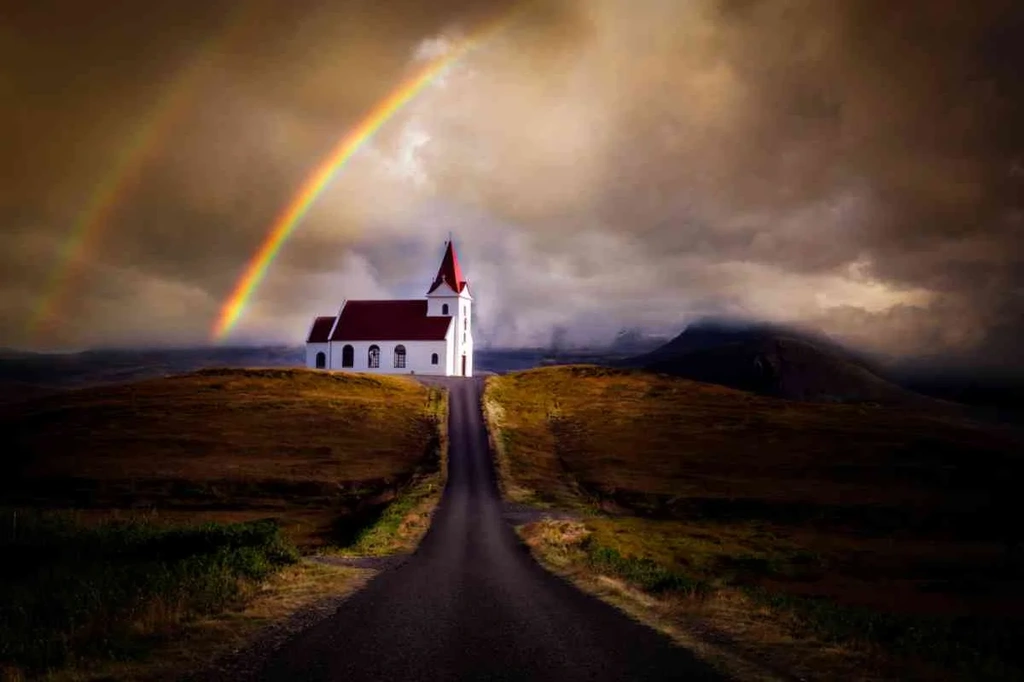
FAQ about Snæfellsjökull
What is Snæfellsjökull?
Snæfellsjökull is an inactive volcano located in the Snæfellsnes Peninsula in Iceland. It is the largest glacier in the peninsula and is one of the most popular tourist destinations in Iceland.
How did Snæfellsjökull form?
Snæfellsjökull formed over millions of years as snow and ice accumulated on the volcano. The glacier is currently about 100 meters thick and covers an area of about 110 square kilometers.
Is Snæfellsjökull dangerous?
Snæfellsjökull is a glacier, and as such, it is important to be aware of the dangers involved. The glacier is constantly moving, and there is always the risk of avalanches. It is essential to stay on the marked trails and to be mindful of your surroundings.









